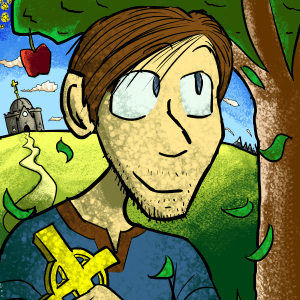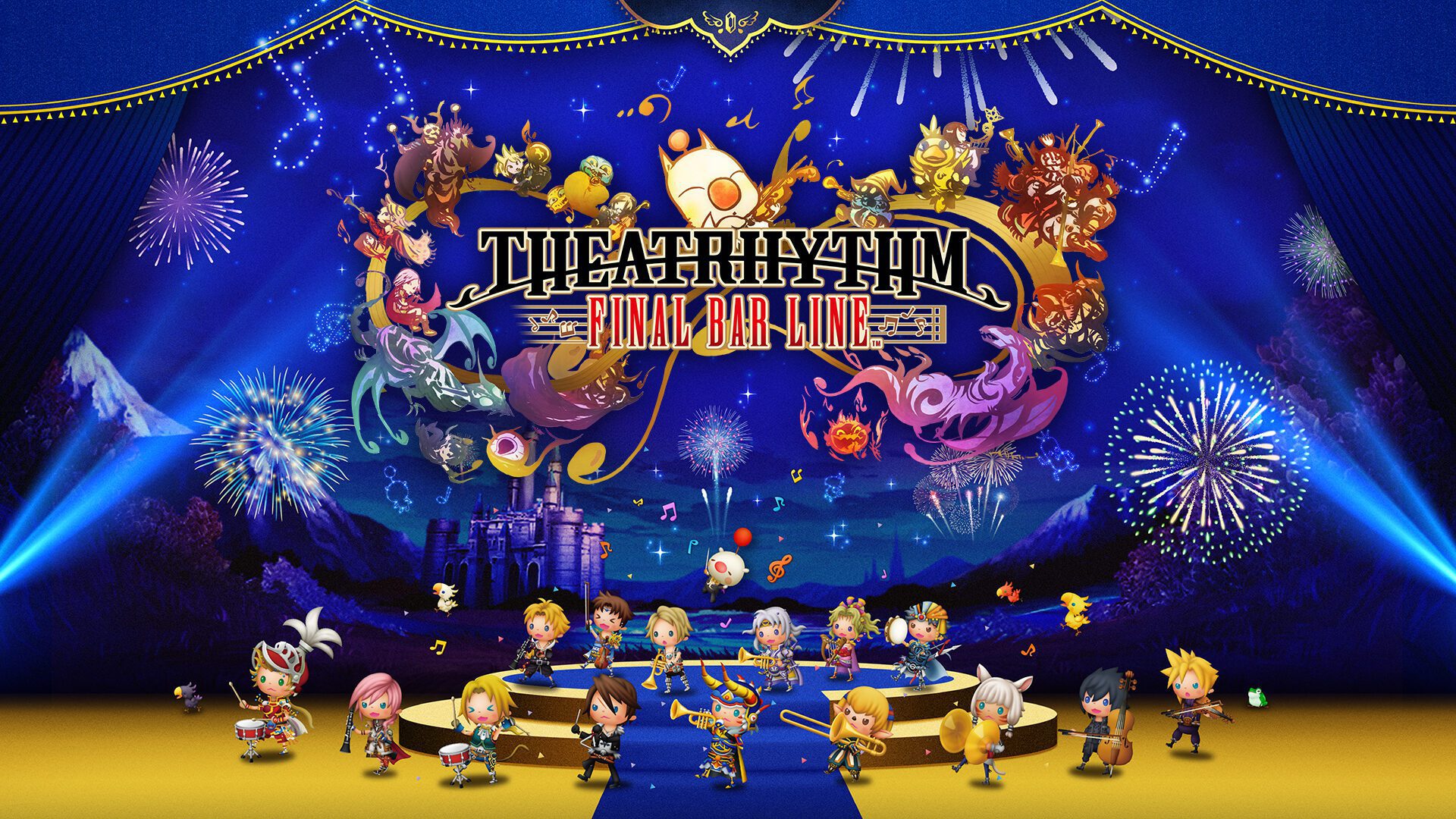
I’m sure many eyebrows will be raised when I say Theatrhythm Final Bar Line was one of my most anticipated games of 2023. Despite the fact that the game is a spin-off of the absolutely monolithic Final Fantasy franchise, it can hardly be considered a blockbusterTriple A title. However, I was absolutely addicted to Theatrhythm Curtain Call back in the days of the 3DS so the prospect of a sequel has been floating around in my head for quite some time. With the release of Final Bar Line I can finally stop fantasizing about the game’s existence and start composing my critique of the game’s quality.
At the risk of oversimplifying things, the rhythm game genre can largely be boiled down to pressing buttons in time with the music and Final Bar Line is no exception in terms of gameplay. Colored circles called triggers scroll from the left side of the screen and the player receives points by performing the correct button command when they reach the right side of the screen. Red triggers denote a quick button tap, yellow triggers require a flick of the control stick in an indicated direction, and green triggers signal that a button must be held down for a period of time. It’s all very straightforward, but the difficulty has been increased somewhat from Curtain Call with the simple addition of triggers that occur simultaneously. Sometimes you’ll be holding down one button to a green trigger while tapping another button to hit red triggers or you might have to flick up on one control stick while flicking down on the other. I know this all sounds incredibly dull, but trust me when I say the amount of focus and dexterity required to succeed on the higher difficulties pushes the simplistic gameplay to its absolute limit.
Final Bar Line also has two extra styles in addition to the standard gameplay. Pair style allows two players to play cooperatively, effectively splitting up the triggers into roughly equal parts for both players. Due to the way Pair style works the players never have to hit more than one trigger simultaneously so if both players are decently competent at the game it’s something of a hidden easy mode. The more overt easy mode is Simple style which removes all yellow triggers and triggers played simultaneously so that the game can be played with a single button. Simple style can still be challenging on the higher difficulties, but overall it’s just not as engaging in my opinion.
On top of all of that there’s an extra layer of RPG mechanics to emphasize the game’s connection to the Final Fantasy series. As the player focuses on keeping the beat and hitting triggers, a party of up to 4 characters will be fighting monsters in the background. If the player is doing well the characters will deal damage to the monsters, collecting experience points and items when the monsters are slain. If the player does poorly the monsters will deal damage to the characters and taking too much damage results in a game over. Additionally, characters can level up and learn powerful abilities to help them defeat more monsters, collect more items, and take more damage. Maintaining a balanced team of powerful characters really comes in handy when playing on harder songs so don’t neglect this aspect of the game.
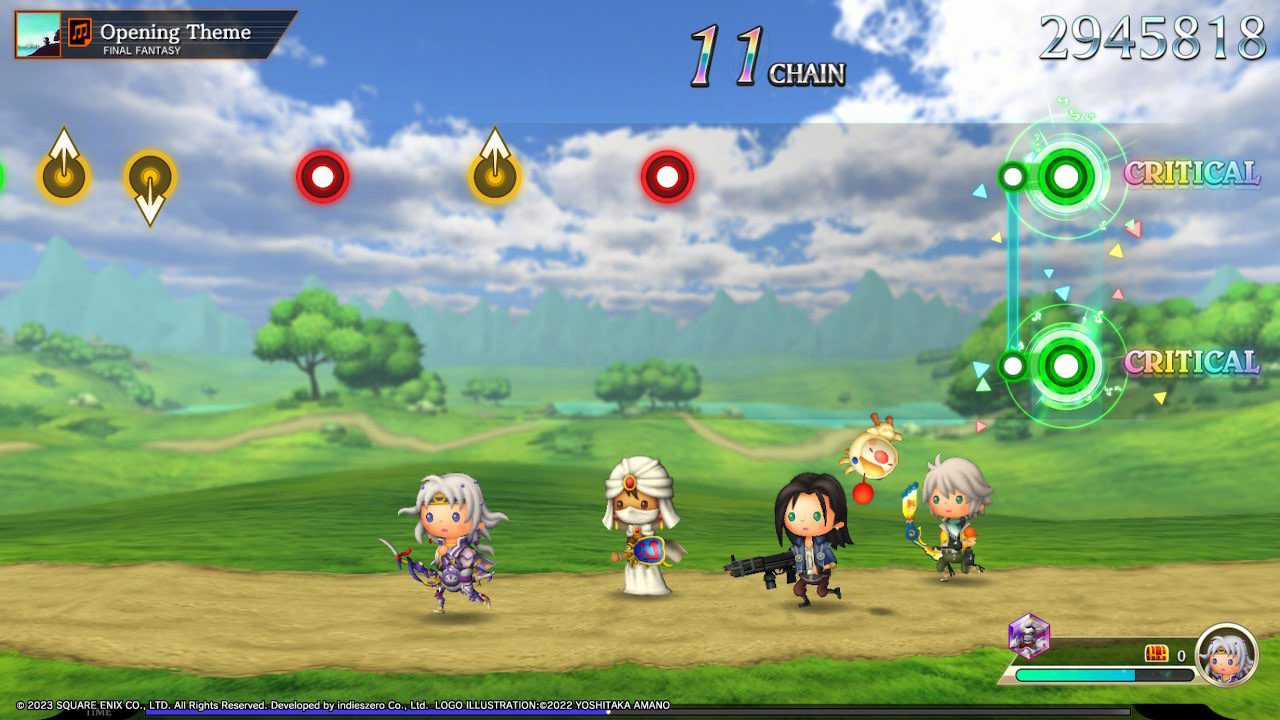
Every era of Final Fantasy in one game makes for some very eclectic looking parties like this one.
There are 3 primary game modes in Final Bar Line; series quests, music stages, and multi battle. Series quests present the player with a set of missions themed around different games in the Final Fantasy series, sort of like an album or playlist. You’ll want to spend most of your time in this mode because it’s how you unlock pretty much everything in the game. When you unlock a quest you also unlock the heroes from the game it’s themed around to use in your party. As you play through a quest you’ll unlock the songs in the other modes. Once a quest has been finished you’ll unlock the series villains to use in your party as well as a bonus stage. There are even side quests within each quest that reward you with unique items when completed! With a grand total of 385 songs and 104 characters to unlock, clearing every quest took me over 20 hours to accomplish and I didn’t even finish all the side quests.
The other two modes are far less complicated than series quests. Music stages are the game’s free play mode. Pick a song, play the stage, and shoot for a high score. See how easy that was? Multi battle is for playing with other people online in which players compete for high scores while trying to disrupt each other with wacky distractions like sending an army of moogles to dance in front of their screens. I doubt this mode will be used for serious competition between hardcore players, but it still might have some value on a casual level.
That’s basically everything Final Bar Line has to offer in terms of gameplay so let’s move onto the game’s music, which is arguably just as important for a rhythm game. 2023 is the 35th anniversary of the Final Fantasy series and while the franchise has had ups and downs over the years the music has always been fantastic. Even among some of the least popular games in the series such as Final Fantasy II, Final Fantasy VIII, and Final Fantasy XIII there are certified ear worms like “The Rebel Army”, “The Man with the Machine Gun”, and “March of the Dreadnoughts”. Needless to say the quality of Final Bar Line’s selection of music is almost as large as its quantity. You don’t even need to have played a single Final Fantasy game in the past to enjoy its music because it is just that good, though I will concede that if you have played a few games in the series the songs you’re familiar with will hit even harder.
The music isn’t completely above criticism however, most notably the over emphasis on certain games in the series. Most of the flagship Final Fantasy titles have somewhere between 10 to 20 songs and 3 to 6 playable characters. Some of the more popular games in the series, or more accurately the most financially successful, often exceed this margin of error due to the number of expansions and spin-offs they get. Final Fantasy XIV alone has 33 songs and the Final Fantasy XIII trilogy has roughly the same number, but the king of the mountain is easily the Final Fantasy VII series with 39 songs and 11 playable characters.
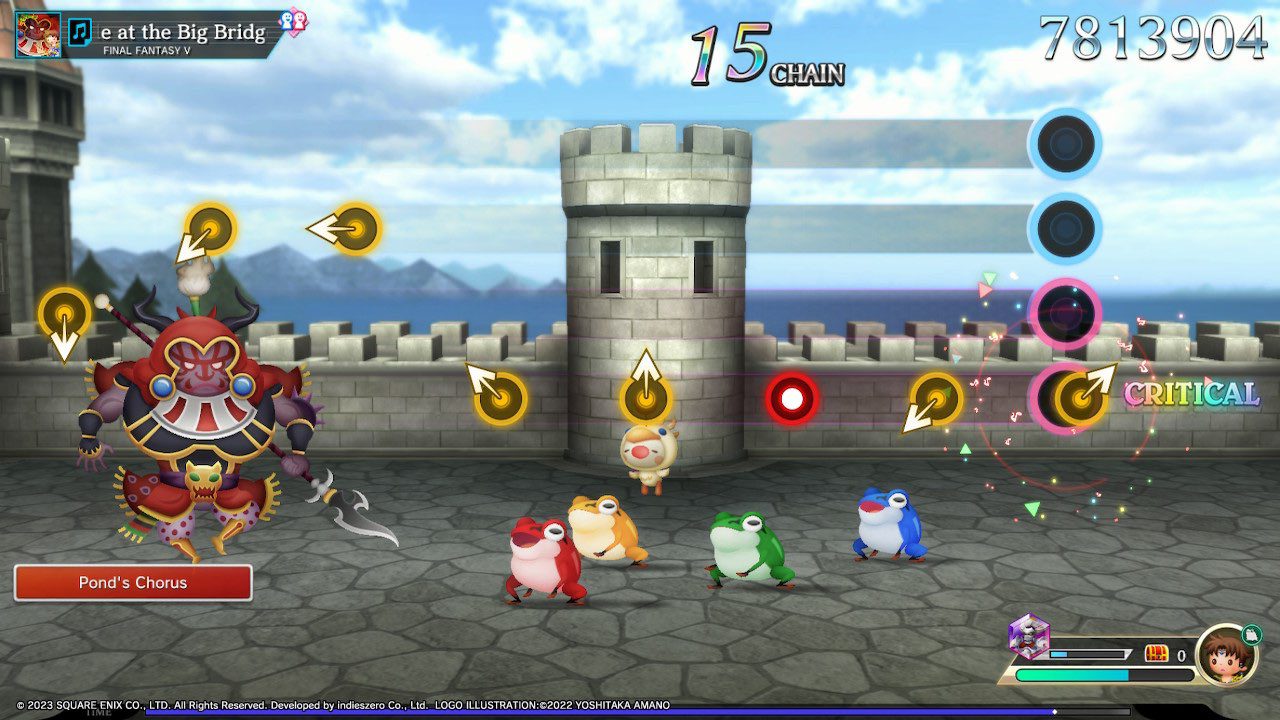
FROG!
Another issue I have is the inconsistent editing of some of the series’ longer songs. For example, “Hellfire” from Final Fantasy XV was originally 6 minutes long, but in Final Bar Line the song has been cut down to be less than 3 minutes long. Normally I wouldn’t see this as a problem, but the fact that Advent Children’s rendition of “One Winged Angel”, which is also 6 minutes long, is in the game unedited comes off as a double standard. On the whole though these are honestly minor complaints compared to how excellent the music selection is.
Then there’s the game presentation which hasn’t changed too much from the previous games, for better and for worse. The characters and monsters are very cartoony and give the game a very lighthearted and upbeat tone which I think works well in the context of a rhythm game. It won’t be everyone’s cup of tea, but I doubt it will be a deal breaker for anyone either.
The stages use still images in the background and 3D models in the foreground to add a sense of depth. Most of the game’s stages are set in generic environments like a forest, a mountain, or a castle so that they can be used across as many stages as possible. However, songs with a strong connection to a distinctive location or climatic story beat will have unique backgrounds to better reflect those iconic moments. Setting a legendary song like “Battle at the Big Bridge” from Final Fantasy V anywhere other than the titular bridge just wouldn’t feel right.
All that being said however, overall the game’s presentation feels very cheap. All of the game’s characters and monsters come from previous games in the Theatrhythm series even though there are new songs in the game that would have benefited greatly from a few fresh faces rather than just slapping down a preexisting monster that vaguely resembles the original scene if you squint hard enough. I already mentioned how the game often uses generic environments over more specific locations whenever it can get away with it, but even the unique stages are mostly just poorly rendered screenshots and maybe a few foreground items if you’re lucky. For a brand as large and beloved as Final Fantasy you’d think they’d add a bit more polish to these elements because as things are now it comes off as laziness.
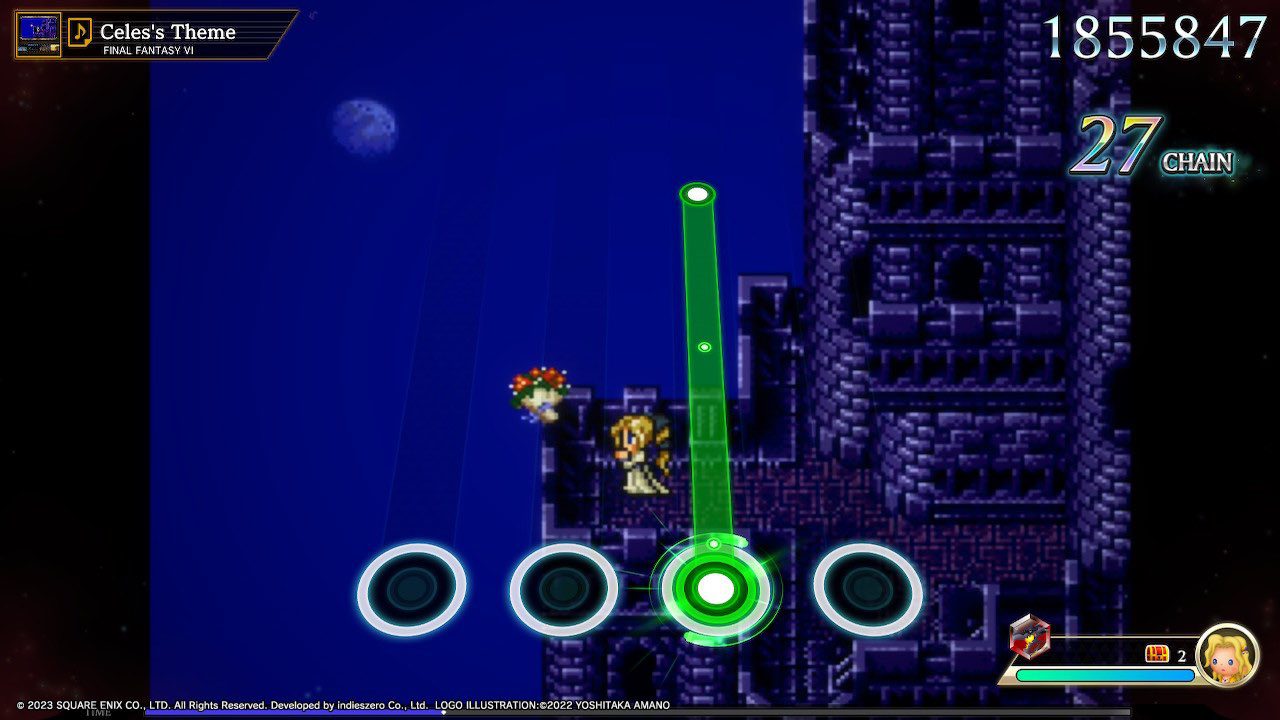
A Final Fantasy VI bonus stage featuring “Celes’s Theme”? I see what you did there Square Enix.
Which brings me to my last point of contention with Final Bar Line, its pricing and DLC. The base game goes for $50 at retail which is a little cheaper than most games from big publishers like Square Enix and for the amount of content in the game it’s not a bad price. However, there are also digital deluxe editions that bundle the base game with its upcoming DLC packs as well as a few exclusive songs only available through the bundle. My first issue with this model is that as someone who bought a physical copy of the game I feel cheated out of those digitally exclusive songs which exist to push the more expensive bundles. My second issue is that the largest bundle that includes all the DLC tracks costs $100, double the standard asking price, and adds less than half the number of songs available in the base game. Anyone with basic math skills can figure out this is an absolutely terrible deal and reeks of cynical corporate greed, over-charging the customers to suck as much money out of them as humanly possible.
Theatrhythm Final Bar Line is easily the definitive edition of this charming little spin-off series with dozens of hours of content themed around some of the best music in video game history. At the same time however, considering the lion’s share of its content is recycled from older games with most of the new songs being sold separately at a huge mark up, it also feels like a huge cash grab. Ultimately I would still recommend the game to anyone who is a fan of Final Fantasy or the rhythm game genre, but only for the game’s base content. Final Bar Line is the video game equivalent of a professional orchestra performing in a garage. It might not look pretty, but it sounds amazing.
Scoring: 80%
Gameplay: 4/5
Visuals: 3/5
Sound: 5/5
Replayability: 4/5
Morality and Parental Warnings: Theatrhythm Final Bar Line has a party of heroes fighting monsters in the background while the player is focused on keeping in sync with the music. The violence is pretty slapstick due to the game’s cartoony artstyle with little to no blood or dismemberment. Some of the characters, among both the heroes and monsters, wear sexy outfits. Characters will cast magic spells in combat such as shooting a fireball or calling lightning down from the sky, though there are no rituals or incantations. A good number of the game’s monsters are pulled from, or at the very least named after, characters and creatures from various pagan mythologies. The game includes bonus stages that act as highlight reels of important moments from each of the major Final Fantasy games, some of which are a bit more graphic than Theatrhythm. The bonus stage for Final Fantasy Type-0 is particularly noteworthy in this regard for its emphasis on the brutality of war.
